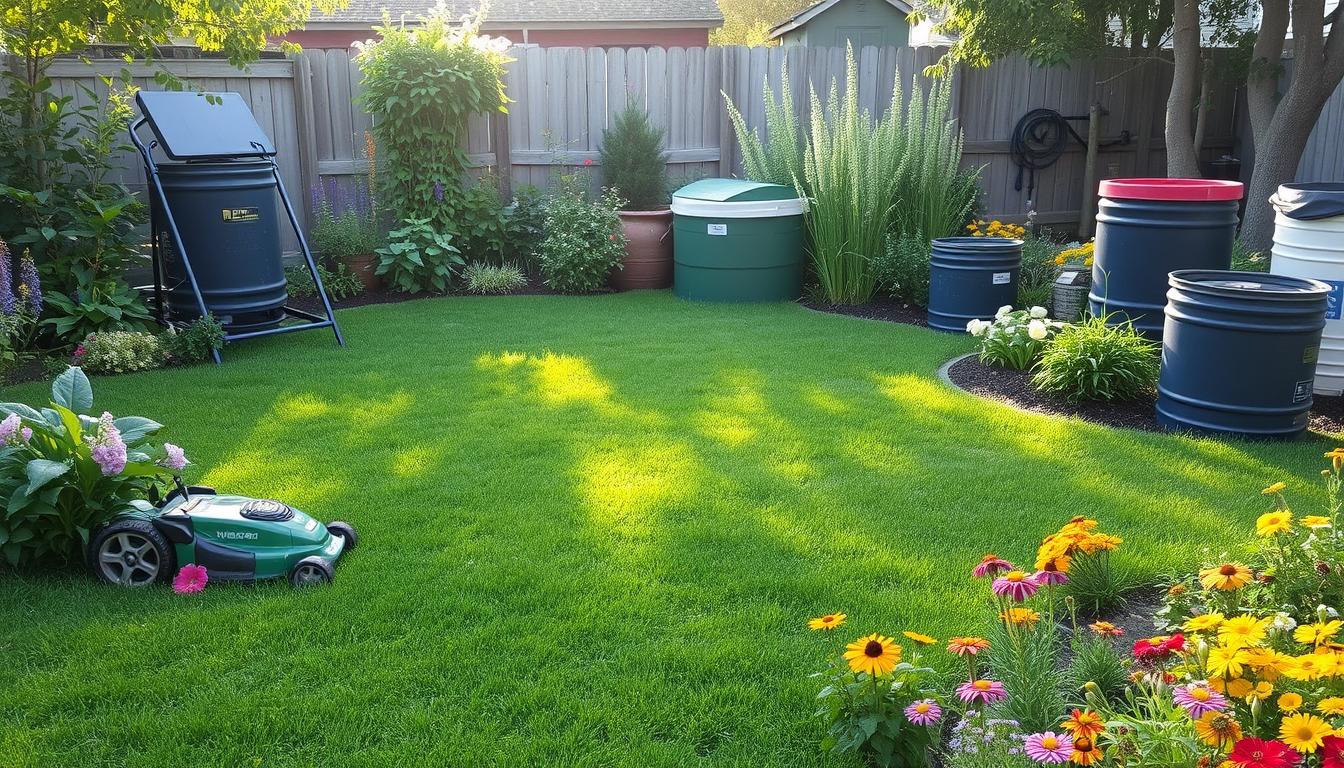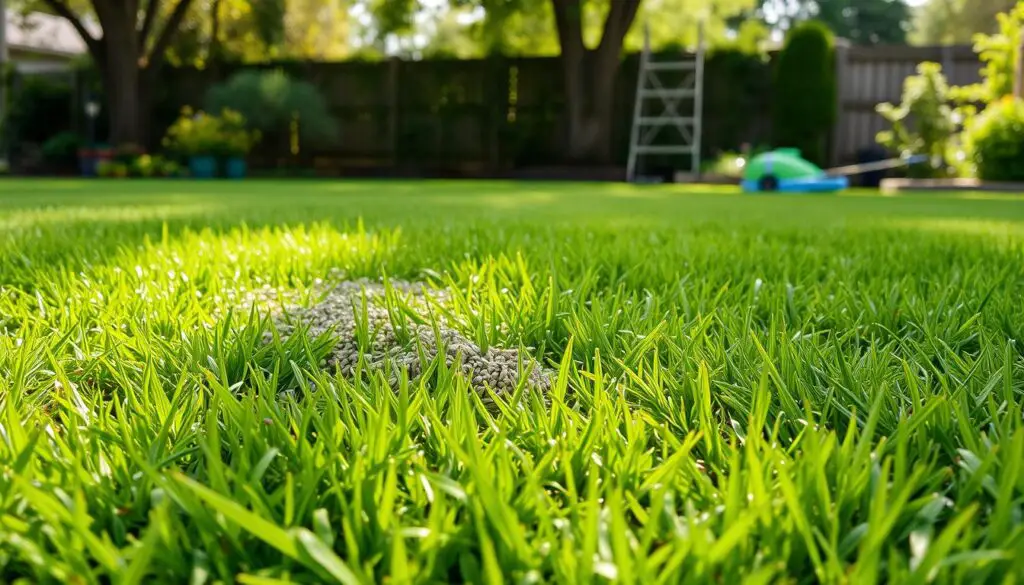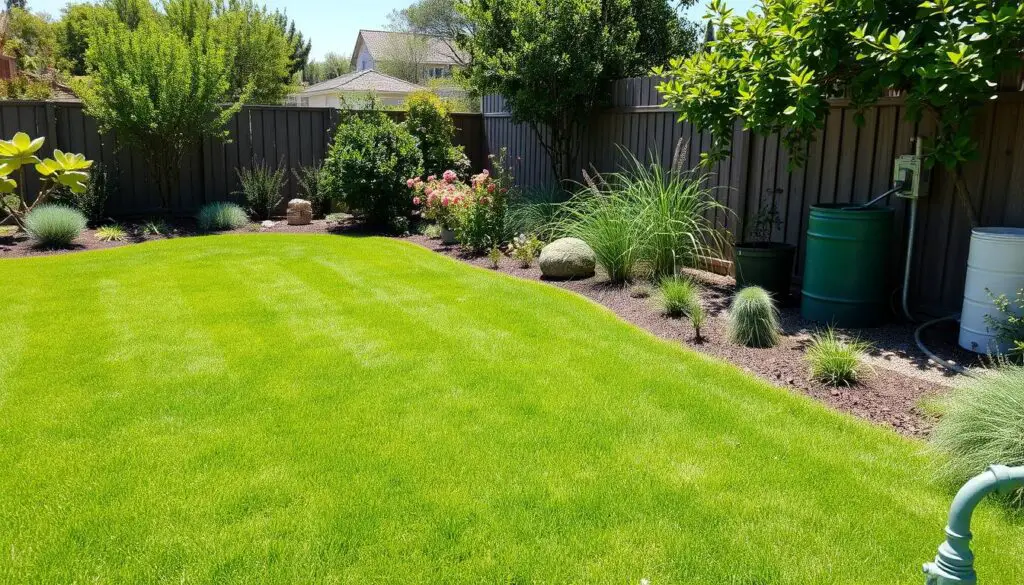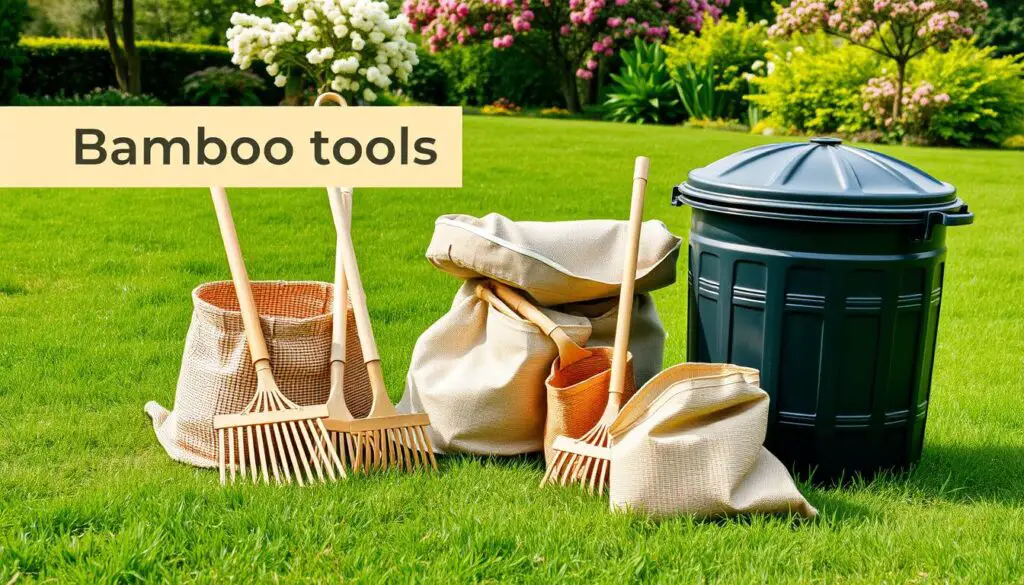Creating a Sustainable Lawn Care Routine

Did you know that turf grass covers an area three times larger than the amount dedicated to corn production in the United States? This fact shows how much our lawn care affects the environment. As a homeowner, I want a beautiful yard without harming the planet. So, I’ve started using eco-friendly lawn care methods.
In this guide, I’ll teach you about sustainable lawn care. We’ll cover overseeding, mowing, soil feeding, and cutting down on pesticides. These tips will help you have a lush, safe lawn for your family, pets, and the environment. Let’s start making your yard greener and more eco-friendly.
Key Takeaways
- Discover the benefits of eco-friendly lawn care practices that save time, money, and the environment.
- Learn how to create a beautiful, low-maintenance yard using natural, sustainable methods.
- Understand the principles of organic lawn care, including proper mowing, responsible soil feeding, and reducing pesticide use.
- Explore water-saving systems and eco-friendly tools to reduce your lawn’s environmental impact.
- Discover ways to increase biodiversity and promote a healthier, more resilient lawn ecosystem.
What is Eco-Friendly Lawn Care?
Eco-friendly lawn care helps your lawn and plants grow without harming the environment. It focuses on making the soil healthy. This way, your grass can fight off pests and weeds naturally. By using eco-friendly methods, you can have a beautiful lawn that’s safe for everyone.
Understanding Eco-Friendly Lawn Care Practices
This approach to lawn care promotes strong, weed-resistant grass. It means mowing your grass high and leaving clippings to nourish the soil. Before using fertilizers, it’s important to test your soil to know what it needs.
Benefits of an Eco-Friendly Lawn
An eco-friendly lawn has many advantages. It improves soil health, uses less water, and supports more wildlife. Plus, it’s a safer place for your family and pets because it avoids harmful chemicals.
| Eco-Friendly Lawn Care Practices | Benefits |
|---|---|
| Mowing grass high, leaving clippings | Healthy roots, return of nutrients to soil |
| Soil testing before fertilizing | Prevents over-application of nutrients |
| Using organic fertilizers | Improved soil structure, reduced water pollution |
| Integrated pest management | Reduced use of harmful chemicals, increased biodiversity |
By using these eco-friendly lawn care methods, you can have a beautiful, healthy lawn. It’s good for the environment and looks great. The Lawn to Lake initiative offers helpful tips and resources for sustainable lawn care.
Overseed Your Lawn Annually
Overseeding your lawn every year is key to keeping it healthy and weed-free. When your lawn starts to thin, weeds can move in. By overseeding, you can grow a thick, lush lawn that fights off weeds naturally.
Marc Mayer says overseeding yearly keeps your lawn dense. He advises against overseeding in spring because weeds compete more. Instead, do it in fall when the soil is warm. Different grasses need different care: warm-season grasses like Bermuda are better for sodding, while cool-season grasses like Kentucky Bluegrass are good for overseeding.
After overseeding, your lawn needs lots of water. Keep watering daily for up to two weeks until the seeds sprout. Once they sprout, water every few days to keep the seeds from failing. Overseeding not only makes your lawn look better but also introduces stronger grass that can handle pests and drought.
Overseeding works best after you’ve aerated your lawn. This lets the seeds get in closer to the soil, making your lawn better. In Minnesota, overseed in late summer to early October for the best results. Fall is better than spring because there’s less weed competition and less stress on the grass.
Watering regularly, for the first 1-2 weeks, is key for new seeding success. It takes 12-18 months for new grass to grow into a thick lawn. Start mowing when the grass is 4″ tall, using a sharp blade and a setting of 3″.
Overseeding makes your lawn thicker, greener, and healthier. It repels diseases, insects, and weeds, and helps roots grow strong. Plus, it’s good for the environment because it doesn’t use chemicals or pesticides.

| Grass Type | Overseeding Recommendation |
|---|---|
| Warm-Season Grasses (Bermuda, Zoysia) | Sodding or Sprigging |
| Cool-Season Grasses (Kentucky Bluegrass, Ryegrass) | Overseeding |
Mow the Lawn Correctly
Proper eco-friendly lawn mowing is key for a healthy lawn. Sustainable mowing practices reduce harsh chemicals. This promotes your lawn’s overall health.
Proper Mowing Techniques
Keep your mower blades sharp for a clean cut. This prevents damage to your grass. Also, never cut more than one-third of the blade length at once. This protects the grass and encourages deeper roots.
Mowing Height and Frequency
- Adjust your mowing height for your grass type. Taller grasses like Bluegrass and Tall Fescue need 3 inches. Shorter grasses like Centipedegrass and Common Bermudagrass prefer 2.5 inches.
- Mowing frequency depends on grass type and conditions. In peak season, mow every four to five days to avoid removing too much blade.
- Don’t mow during the hottest parts of the day. Mow in the cooler morning or evening to reduce grass stress.
By using these mowing techniques, you’ll have a lush, eco-friendly lawn. It will need fewer chemicals and be more resistant to pests and diseases.
“Mowing your lawn correctly is the foundation of a healthy, sustainable outdoor space. Small adjustments to your mowing habits can make a big difference in the long-term vitality of your grass.”
Feed the Soil Responsibly
Healthy, nutrient-rich soil is key for a lush lawn. Start by testing your soil. This tells you what nutrients your lawn needs. Use the right organic fertilizers and avoid too much, to prevent pollution.
Conducting a Soil Test
Soil testing is crucial for knowing your lawn’s nutrient levels. It helps you pick the best eco-friendly lawn fertilization plan. This ensures your grass grows well.
Organic Fertilization Methods
Choose natural, slow-release organic lawn fertilizers like compost. These improve soil health and support beneficial microbes. Using compost and compost tea adds vital nutrients to your lawn.

“Healthy soil is the foundation for a thriving, eco-friendly lawn. By conducting regular soil tests and using natural, slow-release fertilizers, you can nourish your lawn while minimizing environmental impact.” – Sam, lawn specialist
Reduce Pesticide and Fungicide Use
It’s important to cut down on harmful pesticides and fungicides for our lawns. Instead of using chemicals, we should use Integrated Pest Management (IPM). This method focuses on preventing problems and using natural solutions. It keeps our lawns, families, pets, and the environment safe.
Integrated Pest Management
Integrated Pest Management (IPM) is a smart way to care for lawns. It focuses on stopping problems before they start and using natural methods to control pests. This approach helps our lawns stay healthy and strong, reducing the need for harmful chemicals.
- Aerate the soil regularly to improve oxygen and water infiltration, reducing the risk of disease and pests.
- Dethatch the lawn to remove excess thatch buildup, which can harbor pests and diseases.
- Introduce beneficial insects, such as ladybugs and lacewings, to naturally control common lawn pests.
- Utilize IPM techniques to address issues only when necessary, minimizing the use of synthetic chemicals.
By using IPM, we can make our lawns healthy and eco-friendly. This supports the health of our outdoor spaces and the environment around us.
“A healthy lawn does not need regular applications of pesticides or other synthetic chemicals.” – Richard, ecology expert
| Statistic | Data |
|---|---|
| Lawns, covering only 2% of U.S. land, require more irrigation water than any agricultural crop in the country. | – |
| Landfills received approximately 10.5 million tons of leaves, grass, and yard trimmings in 2018, which accounted for 7.2% of all municipal solid waste landfilled. | – |
| Lawns produce more greenhouse gases than they absorb. | – |
| Lawns contribute to the decline of insect populations, affecting pollination and waste decomposition. | – |
Implement Water-Saving Systems
Reducing water usage is key to sustainable lawn care. To keep your lawn lush, try different water-saving systems. Water deeply but not often to help roots grow deep and need less water.
Using rainwater harvesting for lawns is also smart. Set up rain barrels to catch rainwater for your lawn and garden. This cuts down on the need for city water and saves water.
Choose drought-resistant lawn types that need less water. This way, you can lower your lawn’s water use and make it more drought-resistant.
Smart irrigation tech, like soil sensors and efficient sprinklers, also saves water. These tools make sure your lawn gets just the right amount of water, avoiding waste.
| Water-Saving Strategies | Benefits |
|---|---|
| Deep, infrequent watering | Encourages deep root growth and reduces irrigation needs |
| Rainwater harvesting | Reduces reliance on municipal water supplies and conserves water resources |
| Drought-resistant grass varieties | Require less irrigation to maintain a healthy, lush appearance |
| Smart irrigation technology | Ensures precise water delivery and prevents over-watering |
By using these water-efficient lawn care tips, you can cut down your lawn’s water use. This helps save water and makes your outdoor space sustainable and green.

Sustainable Lawn Care
Keeping your lawn green and healthy doesn’t harm the environment. By using eco-friendly lawn care methods, you can have a beautiful lawn that’s also good for the planet. This approach focuses on caring for the soil, using fewer chemicals, and supporting biodiversity. It makes your yard care routine better for the environment and lasts longer.
One important part of eco-friendly lawn care is overseeding your lawn every year. This makes your lawn thicker, fights weeds, and keeps it healthy. Using Pennington Smart Seed grasses can also save up to 30% on water compared to regular grass seed.
Proper mowing techniques are key for a green lawn. Cutting your grass to about 4 inches and using a mulching mower helps the soil. It also cuts down on the need for chemical fertilizers. Plus, mowing the right amount of the lawn at a time helps your grass grow strong.
Using organic fertilizers and getting your soil tested regularly are also important. Knowing what your soil needs and using products like Pennington Full Season Lawn Food 32-0-5 Fertilizer helps your lawn stay healthy. This way, you avoid using harsh chemicals.
Starting a sustainable lawn care routine takes effort, but it’s worth it. You’ll get a beautiful, easy-to-care-for lawn. Plus, you’ll help your local ecosystem and the planet.
Switch to Eco-Friendly Tools
Creating a sustainable lawn care routine means looking at our tools and equipment. Gas-powered mowers, trimmers, and blowers pollute the air and need regular upkeep. Luckily, there are green alternatives that reduce our environmental footprint.
Switching to battery-powered or manual tools is a big step. Eco-friendly lawn equipment and sustainable lawn care tools are now affordable and effective. They let you care for your yard without the pollution and noise of gas machines. These green lawn care products and environmentally-friendly yard tools are better for the planet and quieter for you.
Eco-friendly tools also save you money and hassle. They often have rechargeable batteries, cutting down on fuel costs. Plus, they last longer, reducing waste and saving you money over time.
When buying eco-friendly tools, choose ones made from recycled or sustainable materials. This supports a greener economy and shows your commitment to the environment.
“Making the switch to eco-friendly lawn care tools is a simple yet impactful way to reduce your carbon footprint and contribute to a healthier, more sustainable ecosystem.” – Sam, Lawn Specialist
By choosing eco-friendly lawn equipment, sustainable lawn care tools, green lawn care products, and environmentally-friendly yard tools, you’re making a big difference. This small change can inspire others to join you in making our future greener.

Increase Biodiversity
Making your lawn a biodiversity-friendly oasis is key to an eco-friendly outdoor space. By using native plants and welcoming beneficial insects, your yard can become a vibrant, diverse haven. Changing from a single-type lawn to a diverse area takes time, but the benefits are huge.
Choosing Native Plants
Native plants are essential for a sustainable lawn. They fit well with local weather and soil, needing less water, fertilizer, and pesticides. Native grasses, for example, are hardy, need less water, fight pests and diseases, and boost biodiversity. Choosing native grasses and plants helps your lawn support local life and attract beneficial insects and wildlife.
Creating Habitats for Beneficial Insects
- Keep small, unmowed spots in your yard for shelter and food for pollinators and other helpful creatures. One bat can eat up to 1,000 insects per hour, helping control pests.
- Add features like birdbaths or small ponds for a steady water source, even in dry times.
- Let flowers and seed heads stay on plants until autumn, giving insects and animals food all year.
By making homes and food for beneficial insects, your lawn becomes a thriving, biodiversity-friendly space. This lawn care method not only helps the environment but also makes your yard healthier.
“Leaving flowers and seed heads on plants until the end of autumn provides vital food resources for insects and animals.” – Laura, lawn health expert
Opt for Organic Lawn Treatments
Choosing organic lawn treatments is a smart move for a healthy lawn. These products, like seaweed and bone meal, feed the soil naturally. They avoid the bad effects of synthetic fertilizers on the environment.
These green solutions help your lawn’s ecosystem. They encourage good microbes and cut down pollution risks. The University of Maryland Extension says organic care takes time and money, but it’s worth it in the long run.
Soil pH, between 6.0 and 6.8, is key for grass health. Organic fertilizers like alfalfa meal keep this balance right. They do this without the need for phosphorus unless a soil test says so.
| Organic Lawn Care Practices | Benefits |
|---|---|
| Proper soil pH maintenance | Supports healthy turf growth |
| Using natural, nutrient-rich fertilizers | Provides sustained nutrient release without harmful environmental impact |
| Avoiding synthetic pesticides and herbicides | Protects the lawn’s ecosystem and minimizes pollution |
| Embracing cultural practices like mowing and overseeding | Promotes a dense, resilient lawn |
Going organic means a lawn that’s good for the planet and looks great. It might take more work at first. But, a lush, green lawn is a great reward for your effort.
Choose Suitable Grass Varieties
Choosing the right grass for your area is key to a great lawn. Cool-season grasses like Kentucky bluegrass and tall fescue do well in cold winters and mild summers. Warm-season grasses, such as Bermuda grass, are perfect for hot summers and mild winters. Organic care helps these grasses thrive, needing less water and fertilizers.
Cool-Season Grass Options
Cool-season grasses are great for places with big temperature changes. They grow best from April to October. This makes them perfect for areas with cold winters and warm summers.
Warm-Season Grass Options
Warm-season grasses, like Bermuda grass, love the heat and do well in mild winters. They need less care, making them a smart choice for a low-maintenance lawn.
Picking the right grass is important for a healthy lawn. Knowing the needs of cool-season and warm-season grasses helps homeowners choose the best. This way, they can enjoy a beautiful lawn with less effort.
Promote Healthy Soil Structure
Healthy soil is key to a green lawn. Regular aeration lets oxygen and water reach the roots. This helps the grass grow strong.
Removing thatch and adding compost or top-dressing boosts lawn health. A healthy soil ecosystem means less need for chemicals.
Making soil healthy for lawns is vital. It leads to a lawn that takes care of itself. This way, my lawn stays green and strong without harmful chemicals.
Adding compost or aged manure is great for soil. It keeps water and nutrients in and supports soil microbes. These microbes help break down organic matter and make nutrients for the grass.

